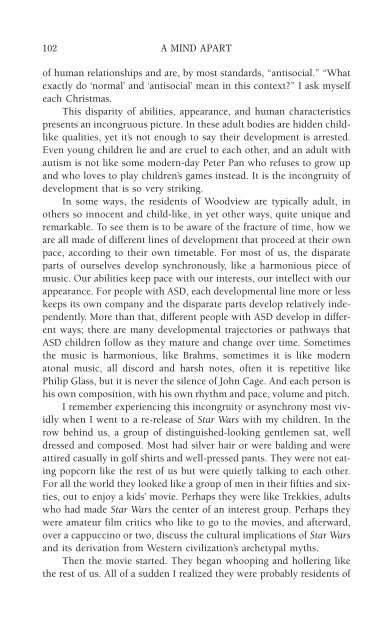978-1572305441
autism
autism
You also want an ePaper? Increase the reach of your titles
YUMPU automatically turns print PDFs into web optimized ePapers that Google loves.
102 A MIND APART<br />
of human relationships and are, by most standards, “antisocial.” “What<br />
exactly do ‘normal’ and ‘antisocial’ mean in this context?” I ask myself<br />
each Christmas.<br />
This disparity of abilities, appearance, and human characteristics<br />
presents an incongruous picture. In these adult bodies are hidden childlike<br />
qualities, yet it’s not enough to say their development is arrested.<br />
Even young children lie and are cruel to each other, and an adult with<br />
autism is not like some modern-day Peter Pan who refuses to grow up<br />
and who loves to play children’s games instead. It is the incongruity of<br />
development that is so very striking.<br />
In some ways, the residents of Woodview are typically adult, in<br />
others so innocent and child-like, in yet other ways, quite unique and<br />
remarkable. To see them is to be aware of the fracture of time, how we<br />
are all made of different lines of development that proceed at their own<br />
pace, according to their own timetable. For most of us, the disparate<br />
parts of ourselves develop synchronously, like a harmonious piece of<br />
music. Our abilities keep pace with our interests, our intellect with our<br />
appearance. For people with ASD, each developmental line more or less<br />
keeps its own company and the disparate parts develop relatively independently.<br />
More than that, different people with ASD develop in different<br />
ways; there are many developmental trajectories or pathways that<br />
ASD children follow as they mature and change over time. Sometimes<br />
the music is harmonious, like Brahms, sometimes it is like modern<br />
atonal music, all discord and harsh notes, often it is repetitive like<br />
Philip Glass, but it is never the silence of John Cage. And each person is<br />
his own composition, with his own rhythm and pace, volume and pitch.<br />
I remember experiencing this incongruity or asynchrony most vividly<br />
when I went to a re-release of Star Wars with my children. In the<br />
row behind us, a group of distinguished-looking gentlemen sat, well<br />
dressed and composed. Most had silver hair or were balding and were<br />
attired casually in golf shirts and well-pressed pants. They were not eating<br />
popcorn like the rest of us but were quietly talking to each other.<br />
For all the world they looked like a group of men in their fifties and sixties,<br />
out to enjoy a kids’ movie. Perhaps they were like Trekkies, adults<br />
who had made Star Wars the center of an interest group. Perhaps they<br />
were amateur film critics who like to go to the movies, and afterward,<br />
over a cappuccino or two, discuss the cultural implications of Star Wars<br />
and its derivation from Western civilization’s archetypal myths.<br />
Then the movie started. They began whooping and hollering like<br />
the rest of us. All of a sudden I realized they were probably residents of



